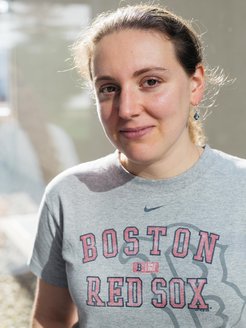Kathryn Arpino
Humboldt Fellow since August 2018

Structure-property relationships – how the structure of a material underlies and affects its properties – are at the heart of solid-state chemistry and condensed matter physics; moreover, these relationships can be implemented to intentionally design functional advanced materials for myriad practical applications. One variable structural feature is the stereochemical activity of s2 lone pair: whether these electrons are spherically distributed (“stereochemically inactive”) or displaced relative to their atom (“stereochemically active”) due to contribution of other orbitals or bands. With her Alexander von Humboldt Postdoctoral Fellowship, Dr. Arpino aims to experimentally investigate how lone-pair stereochemistry affects superconductivity and topological character. This avenue of research is warranted due to the band structures associated with stereoactive lone pairs and due to the effects lone-pair stereochemistry has on structural symmetries and on electron density patterning: the band structures and physical symmetry changes are relevant to topological surface states characterized by time-reversal (Z¬2) and crystalline (TCI) symmetries, respectively, and the patterning of s electron density is already proven to be able to effect superconductivity through electron-phonon coupling, such as in BaBi1-xKxO3. In order to investigate the potential relationships of s2 lone pair stereochemistry with superconductivity and topological character, Dr. Arpino modulates stereochemistry gradually and measures physical properties as a function of the stereochemical and structural change. The chemical and physical methods of isovalent chemical substitution and applied pressure provide vectors to modulate lone-pair stereoactivity.
From the beginnings of her interest in science, Dr. Arpino has been drawn to the intersection of chemistry and physics: working in joint and interdepartmental labs, merging the two disciplines in her undergraduate major, and collaborating across departmental borders. In the Felser group at the Max Planck Institute for Chemical Physics of Solids, an interdisciplinary team with backgrounds in chemistry, physics, and materials science and skill sets in experiment, theory, and instrument specialization work together to discover, investigate, and explain novel material properties. This wealth of knowledge working together toward a comprehensive understanding of a material attracted Dr. Arpino as it shares her belief that a complete material story is not restricted by, and indeed is often hindered by, strict borders between the academic departments. Moreover, the Max Planck Institute offers a unique consolidation of relevant knowledge to draw upon. With her AvH fellowship, Dr. Arpino hopes to advance as a self-directed researcher and to foster international collaborations in the future through the lifetime Humboldtian network.
